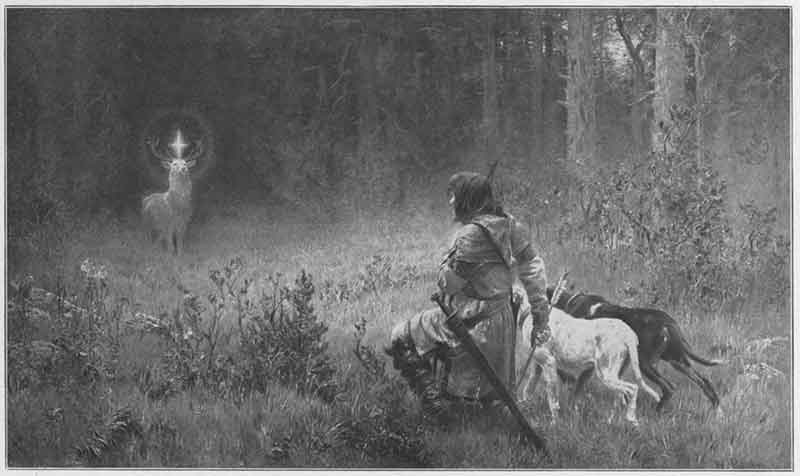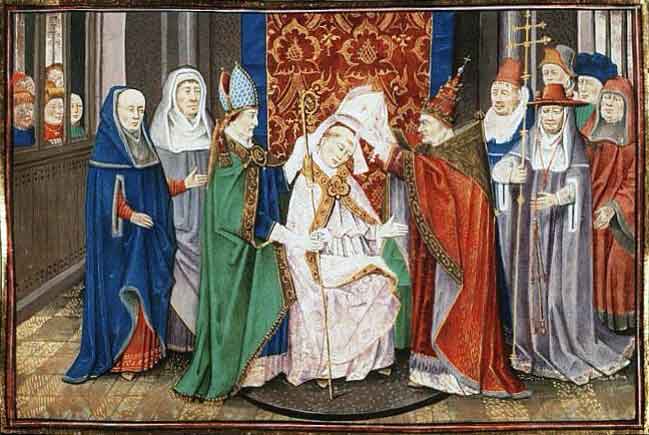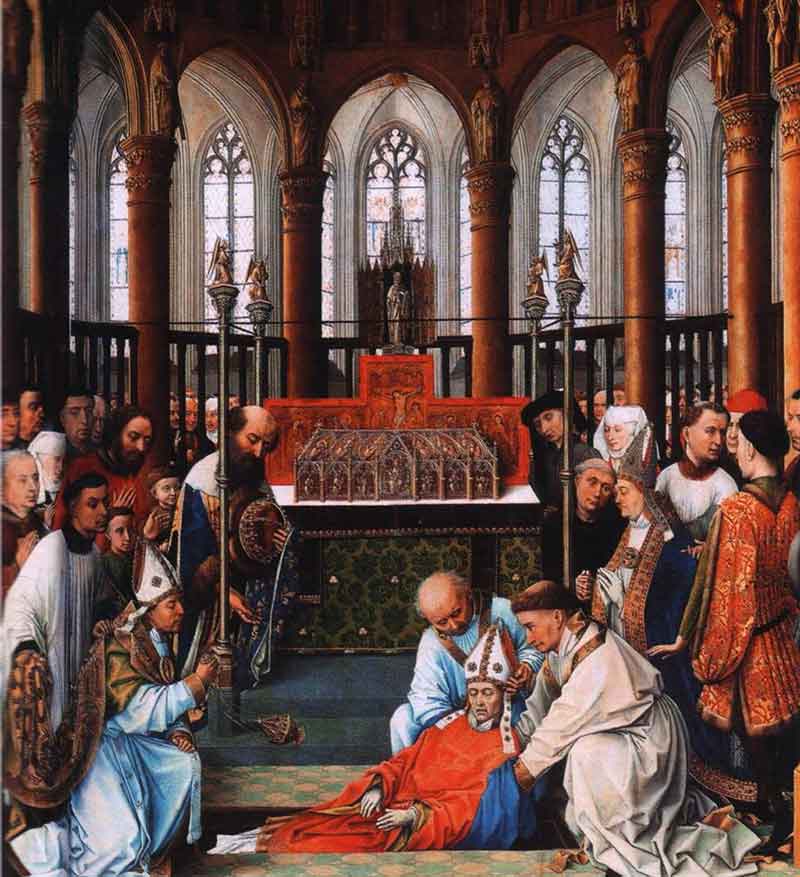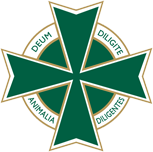The History of St. Hubertus
THE LEGEND OF ST. HUBERTUS
HISTORICAL NOTE: The following is the Legend of St. Hubertus as popularized through the ages. Historical writings and source documents have been consulted and verification of dates and facts has been made where possible. However, as with any history which spans 1,000 years, complete accuracy is difficult to achieve and cannot be assured.

Saint Hubertus, Bishop of Liege (c. 656–727 A.D.)
Hubert was noble-born circa 656AD into French nobility, probably in the European city of Toulouse. He was the eldest son of Bertrand, Duke of Aquintaine, and, thus, heir to the Duchy and all of the appurtenant wealth and hereditaments. Hubert was also the grandson of Charibert, King of Toulouse, and a descendant of the legendary Pharamond, King of Francs.
As legend has it, Hubertus was raised among the splendors of court life and was afforded the finer things in life, including the best education, military training, and ample time for leisure. He had vast wealth, influence and importance, and was described as intelligent, physically handsome, energetic and personable.
At an early age, Hubert was drawn to one of the pleasurable activities of young nobles, the hunt, called la chasse. In fact, the hunt of animals was the primary activity in which he spent his days. His love for the chase was such that he gradually stopped practicing any religious affiliation, instead spending his days in the fields and woods, trapping and hunting.
It is said that Hubert was a renowned bowman, often exhibiting his marksmanship in competitions. He devoted most of his time, even on holy days, to the hunt, a sacrilege in the God-centered times of the Middle Ages.
According to legend, at the Court of Theuduric in Metz Hubert met Floribanne, daughter of a noble, who, while a pious and devoted Christian, liked to ride and frequently accompanied Hubert on his hunts. In 682, they married to great court pomp and ceremony. A son, Floribert, was born to them. Shortly after giving birth, however, Floribanne became ill and she died at the beginning of Holy Week in 684.
As the legend continues, on that Good Friday morning, when the faithful were crowding the churches, Hubert went out to hunt. As he was pursuing a magnificent stag, the animal turned and Hubert was astounded to see a vision of a crucifix standing between its antlers.

He heard a voice from Heaven saying: “Hubert, unless you turn to the Lord, and lead a holy life, you shall quickly go down into Hell.” Hubert dismounted and fell to his knees saying, “Lord, what wilt Thou have me do?”. The Heavenly Voice replied, “Go and seek Bishop Lambert, and he will instruct you.”.
After his vision, Hubert renounced all of his royal titles and hereditaments. This included the right to succeed his father as Duke of Aquitane, which he conferred upon his younger brother, Eudon, in whose care he also placed his infant son, He gave his considerable wealth and possessions to the poor, and set out immediately for Maastricht where Bishop Lambert received Hubert kindly, and became his spiritual advisor.
Lambert directed Hubert to go and live among the people and creatures of the nearby forest of the Ardennes, and to devote himself to prayer and study. Hubert did so, and studied for the priesthood, into which he was soon ordained, and shortly afterwards became one of Bishop Lambert’s chief associates in the administration of his diocese. Hubert made a pilgrimage to Rome in 708, during which Bishop Lambert was assassinated. Pope Sergius I consecrated Hubert as 31st Bishop of Maastricht. He later became first Bishop of Liege, and was widely known as the Apostle of the Ardennes.

Bishop Hubert was diligent in fasting and prayer, and became famous for his eloquence in the pulpit. He remained steadfast in his concern for the needs of the people and creatures of the forest and set out to convert the pagans and bandits of the Ardennes Forest. It is said that he made many forays into the forest for that purpose, and used his considerable archery skills to gain their respect and trust, at which time they became more receptive to the Gospel. Hubert was ultimately able to convert many of these people to Christianity. He became an advocate for the people of the forest and his wise judgment and intercession was frequently sought in many matters, including those involving the forest, wildlife, and hunting.
Bishop Hubertus had unusual healing powers which he used to relieve people of various afflictions, and these miraculous acts became widely known. The faithful began making pilgrimages to Hubertus’ Cathedral in Liege to seek his help, and many miraculous acts by Hubertus were chronicled.
On May 30th, 727, Hubert died peacefully at the age of 71 in Fura, now Tervueren, located 30 miles from Liège. He was buried in the college church of St. Peter, Liège. In 825, Bishop Hubert’s remains were exhumed and transferred to the Benedictine Abbey of Amdain, the present day Saint Hubertus, Belgium.

Soon, the stories of miraculous events of healing at Hubertus’ tomb spread. Over the following centuries, frequent pilgrimages of believers have been made to Hubertus’ tomb.
Hubertus was canonized St. Hubertus in 743 AD. St. Hubertus is recognized as a saint by the Roman Catholic, Eastern Orthodox, and Anglican/Episcopal churches. St. Hubertus is the patron saint of hunters, hunting dogs, archers and bowmen, and the inhabitants of the forest. St. Hubertus is also the patron saint of Liege and Saint-Lamberge, Belgium. His Feast Day is November 3rd.
Saint Hubertus was widely venerated during the Middle Ages and, it is said, partly because of his noble birth, several military orders were named after him. The first to be associated with St. Hubertus was the Order of St. Hubertus created by Ludwig I of Bar and Lorraine on May 31, 1416. Other past orders honoring St. Hubertus were Bavarian and Bohemian orders, the Fraternity of St. Hubert Knight, and the Order of the Golden Stag, founded in 1672 by the Duke of Brieg, whose emblem was a golden leaf with the imprint of a deer. The Order of St. Hubertus was established in 1695 by Count Anton von Spork to honor the name and memory of St. Hubertus and to promote responsible and ethical hunting and wildlife conservation. This organization continues today as the International Order of St. Hubertus.



